Medieval Music: Harmonious Echoes of the Past
Lets explore medieval music — its evolution, instruments, and lasting influence on musicology.
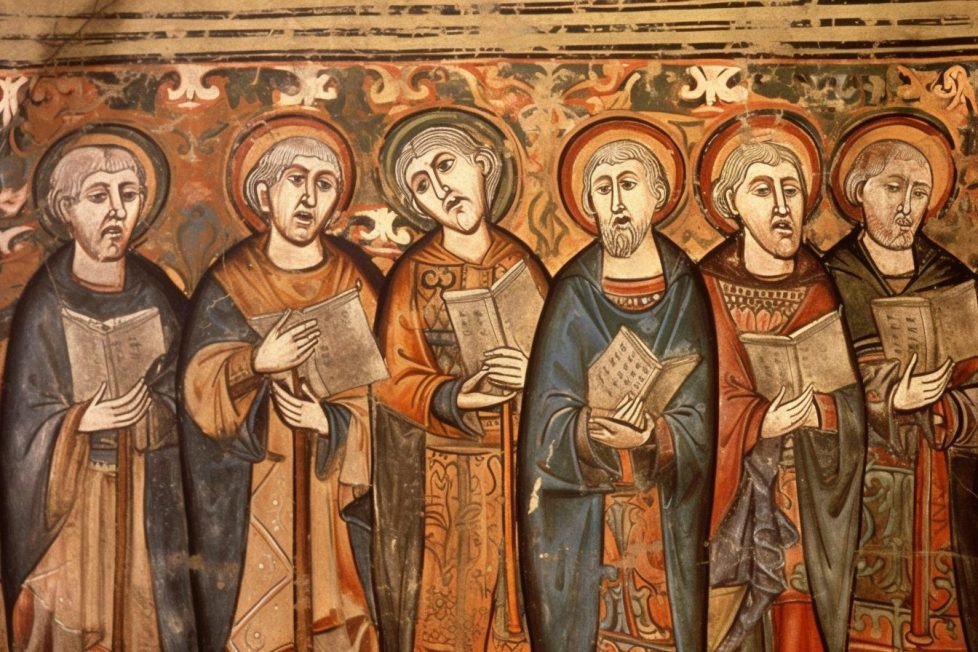
Lets explore medieval music — its evolution, instruments, and lasting influence on musicology.

Table of Contents
ToggleSome people believe that the Middle Ages was a dark time and not much was happening back then, but this is far from the truth. On the contrary, it was a period of great innovation and discovery. The period also laid the foundations upon which succeeding generations would build upon and be inspired by (for example, the operas of Richard Wagner and some works by Duruflé and Carl Orff).
The medieval period of music spans almost a millennium (476 C.E. to 1400) and is the most extended period in music history. We’ll look at some of the highlights from this period and how it shaped the course of music history.
Generally, musicologists divide this period into three mini-periods for ease of reference:
Before the Early Medieval period, Christians suffered prosecution from the Apostolic times until the Edict of Toleration by Galerius of 311 was declared. It should be noted the prosecution wasn’t continuous before the proclamation. The Edict of Toleration, in addition to the Edict of Milan (313), allowed Christianity to flourish. Until the fall of Rome in 476 C.E. public worship was possible. Basilicas were built or adapted for public Christian worship in Rome within decades. The latter two hundred years of this period are significant because we see the emergence of music being written down for performance.
The first known music from this period is known as Chant or Plainsong. Unfortunately, much of the music from this period is lost due to deliberate destruction, floods, fires, and other environmental conditions.
Plainsong was monophonic – one voice singing at a time – and had a non-metric rhythm, i.e., there was no set rhythmic pattern to sing the music. Later, Western music’s rhythm would become metered according to predetermined rules. Chant melodies can be divided into three categories:
Furthermore, there were three methods of singing chants and other psalms, solo, responsorial, and antiphonal. Solo was performed by an individual singer or the choir as a unit. In responsorial singing, the soloist (or choir) would sing a series of verses, and the choir or the congregation sang a response. Finally, the choir and soloist would alternate in antiphonal singing, or the choir and congregation would sing alternately. The chorus could also be divided into two parts, each singing the responses. It’s important to remember that singers had to memorize the chants because written music was not invented yet.
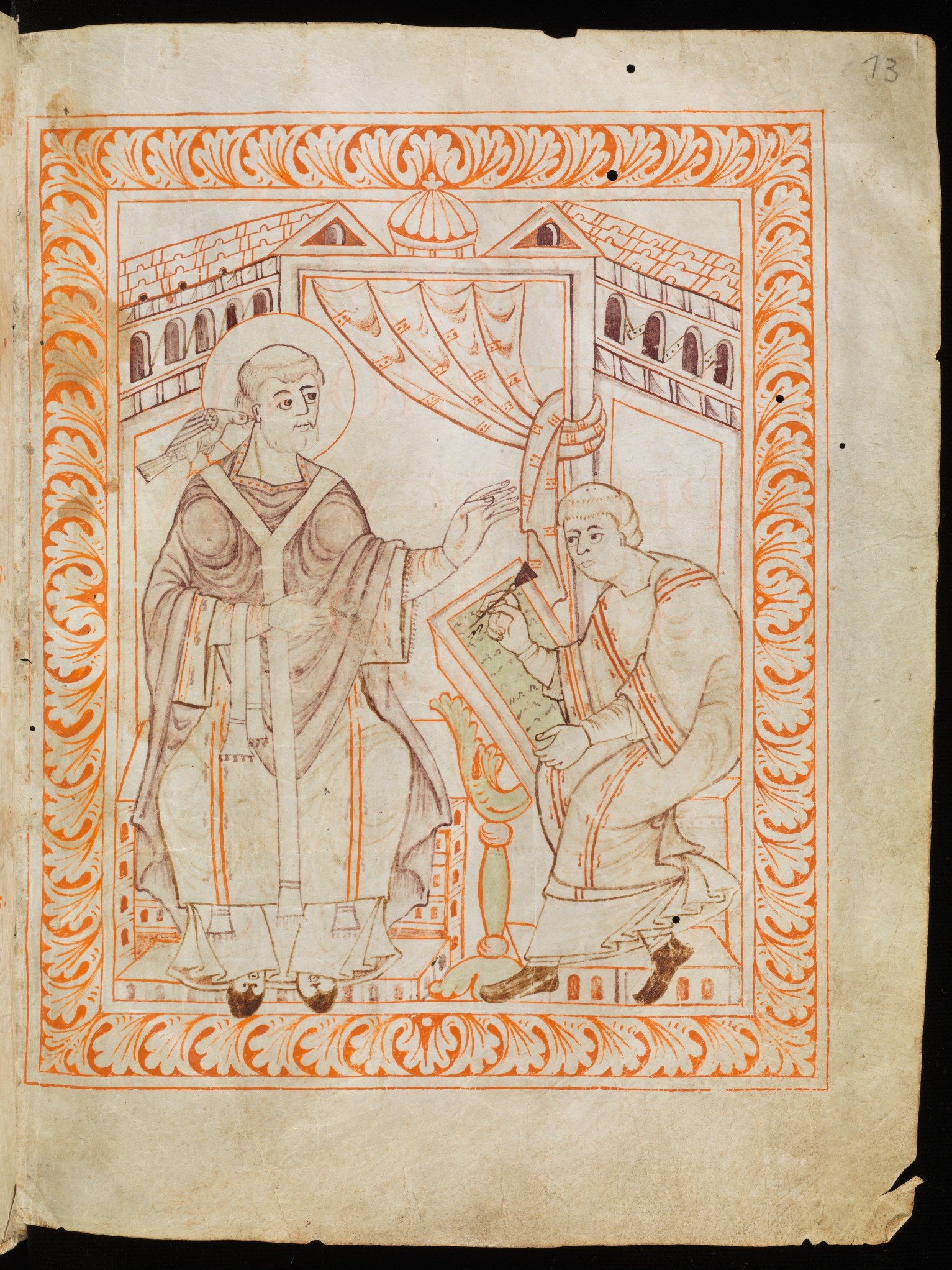
Pope Gregory I (c. 540—604) is credited with inventing the Gregorian chant, although his involvement is up for debate. According to legend, Pope Gregory was divinely inspired by the Holy Spirit as a dove. He dictated the chants to a scribe (seen in the image below). The church used this clever propaganda tactic to show that the chants were divinely inspired and authentically helped cement its place in the church.
It would be another two hundred years before the first written music would emerge. Before we can get to written music, we need to look at the influence of the Roman Catholic Church and the political landscape to see how their goals of unifying not only the land but also the import of Roman liturgy and chant.
Pepin the Short reigned between 751 and 768. During this time, Pope Stephen II took a sojourn in the Frankish Kingdom between 752 and 754. The pope may have traveled with the Schola Cantorum (more about them in a bit), which may have inspired Pepin the Short to seek a unified liturgy and music throughout his domain.
Pepin the Short embraced the Roman liturgy and blended it with the Gallican chant repertoire. The Gallican musicians accepted the primary form of the Roman chant, but they embellished it in an entirely distinct way. The blending of Roman and Gallican chant gave rise to what is now known as Gregorian chant.
Charlemagne, reigning between 768 and 814 C.E., expanded the Frankish kingdom. Pope Leo III crowned Charlemagne emperor of the Holy Roman Empire in 800 C.E., further strengthening the power between the Frankish Empire and the church. With the ties firmly established between Rome and Charlemagne, the Roman liturgy began to spread across the Holy Roman Empire. Charlemagne also ensured that music followed the rules and examples set by Rome (and the Schola Cantorum). This would soon change, and the balance of musical power would tilt to the Notre Dame School in Paris.
Pope Gregory I established the Schola Cantorum after being elected Pope of the Roman Catholic Church in 590. This was the vocal school that established the authoritative (and correct) delivery of the musical liturgy across Europe. Students (boys and men) with the best voices were picked from the church-directed schools to train in the Schola Cantorum. The most gifted student was dubbed ‘paraphonist’ and was in charge of singing the ‘alleluia’ solos. The Schola Cantorum studies lasted nine years; during this time, students had to memorize all the chants. Only the director or paraphonists were permitted to have a book containing chants while on duty.
The group comprised between twenty and thirty boys or men — women were not permitted to join the Schola Cantorum. This group of boys and men was required to shave their heads and wear chasubles. The choir, priest, and congregation sang the service’s ensembles, leaving the most significant passages to the skilled vocalists. The chant dominated ecclesiastical music until the development of polyphony in the eleventh century.
In the eleventh century, two or more simultaneous lines of independent melody accompanied by high and low-pitched voices felt more appropriate for ecclesiastical music. However, until the sixteenth century, when opera came to dominate the musical world, polyphonic composition was continually evolving.
The first evidence of ‘written music’ is found in Codex Sangallensis 359, also known as the Cantorium of St. Gall. The manuscript shows the first use of neume notation. It is one of the primary sources musicologists, and researchers consulted to reconstruct Gregorian chant. The manuscript dates between 922 and 926. Writing down the melodies meant all congregations across the Holy Roman Empire would sing the same music.
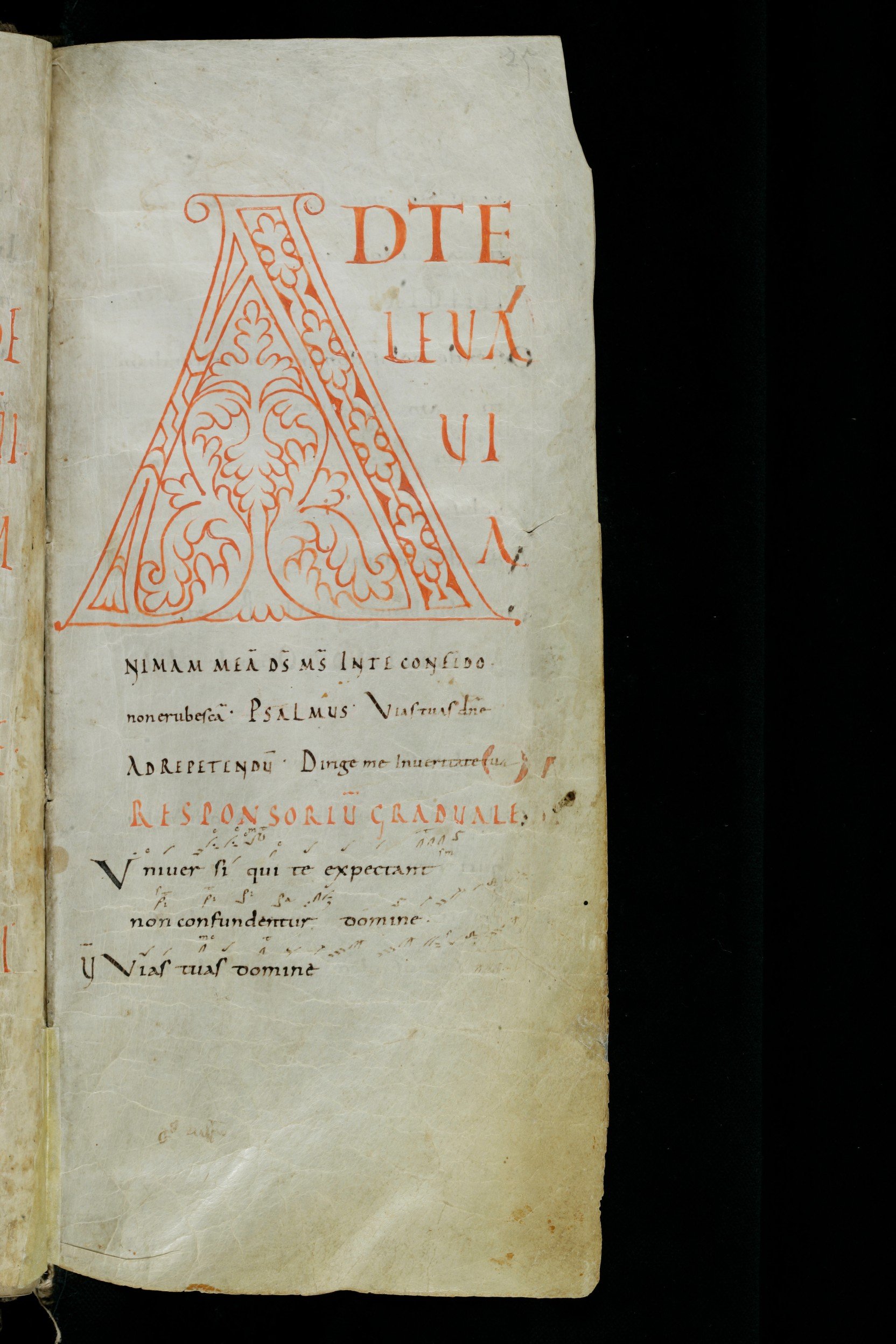
Musicians still had to learn the melodies by rote, but neumes placed above the notes helped them ‘see’ the form and shape of the melodies. The neumes, written above the words, indicated the melodic structure for each syllable and the number of notes per syllable, whether the melody ascended or descended or even if they should repeat a pitch.
While the addition of neumes assisted singers in knowing the primary form of the music, it still did not indicate pitch or duration. More improvements emerged as time went by. A scribe at the Abbey of St. Martial de Limoges added a horizontal line to represent the pitch F. Neumes was grouped above and below the line to show their relation to the F-pitch, i.e., whether it was higher or lower than the pitch. These were called diastematic neumes, shown in the image below, dating from ca. 1030.
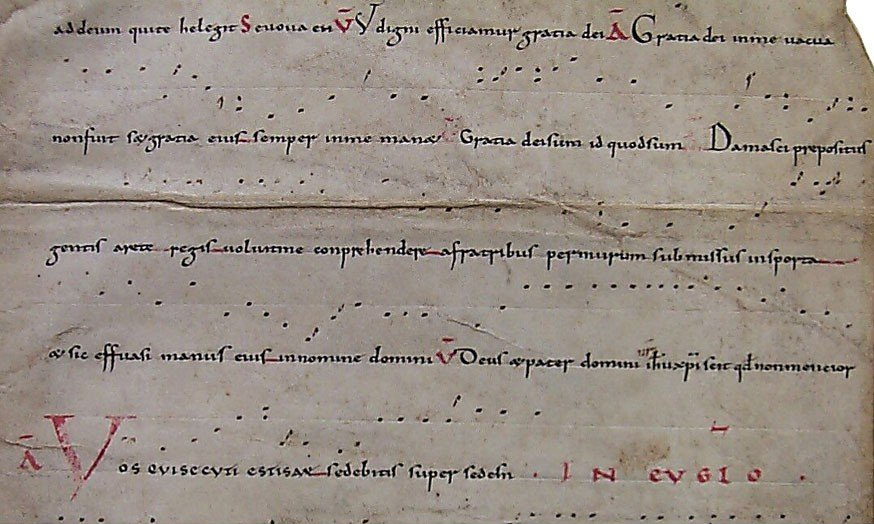
On the recommendation of Guido of Arezzo (c. 990—1050), neumes were transformed once more, and music started to move in the direction of the modern five-stave printed music we use today. Guido recommended the F-pitch should be shown with a red line and the C-pitch with a yellow stripe. Lines and spaces emerged, and scribes added another two lines for the pitches A and E. On the left margin of the pitches, F, A, C, and E were shown to help musicians use the correct pitch while singing. The image below was copied around 1150.
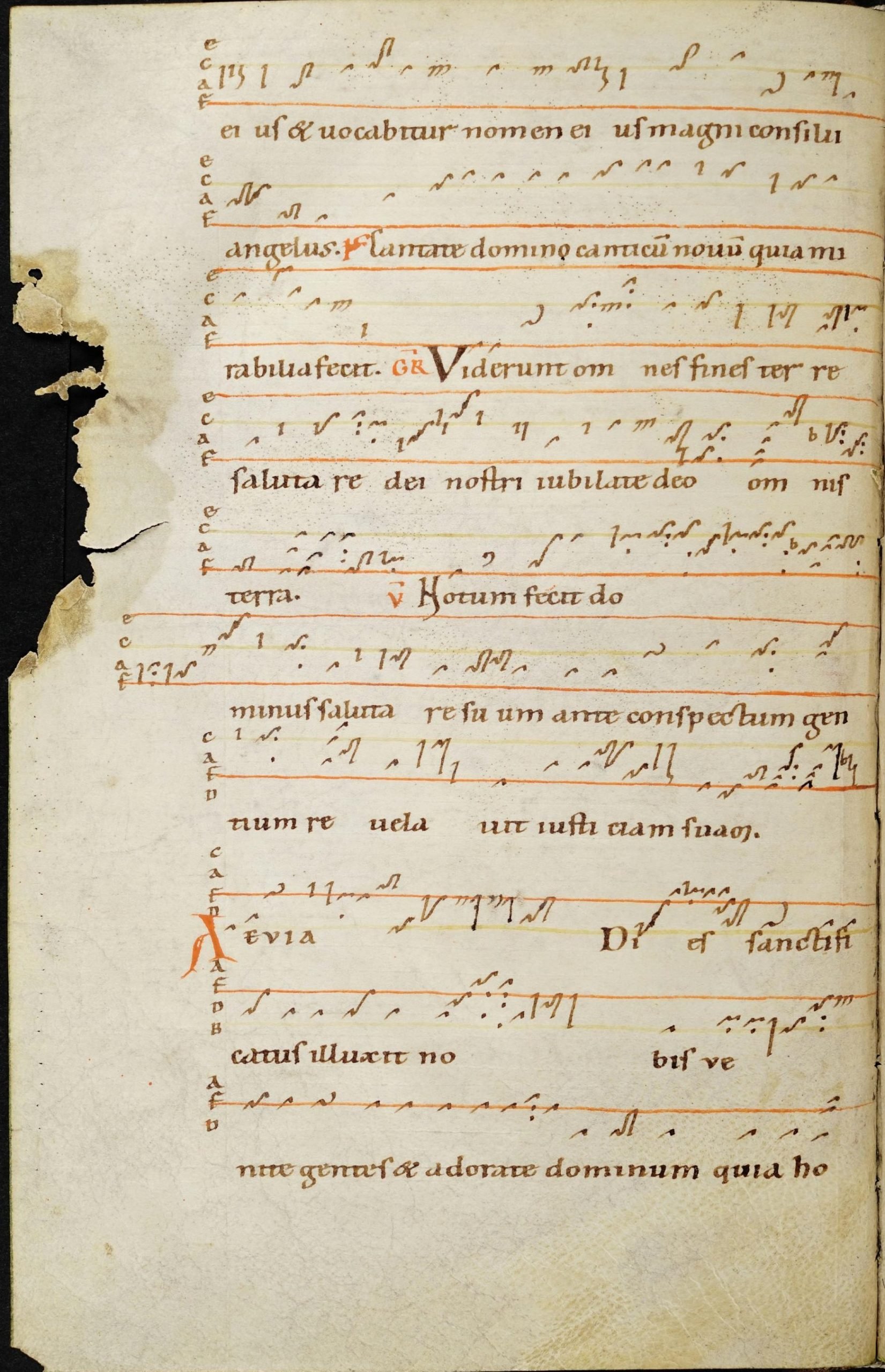
The ‘invention’ of writing music down, first in neumes that looked like little scribbles above the text, was a significant step forward in the history of music. But, apart from this step forward, other developments also emerged.
Organum was an early form of polyphony and emerged around the ninth century. Music was possibly performed in multiple parts before it was written down. The simplest type of this early polyphony is performing a song against a drone (the long-held chant notes in the lowest voice), with quicker-moving metrical rhythms in the top vocal(s). Another form of medieval polyphony was to place consonant (good-sounding) intervals against the melody notes. Thus, it was two notes sounding simultaneous.
The practice of organum was based on two treatises, Musicaenchiriadis (‘Music Handbook’) from ca. 895 and its accompanying text, Scolicaenchiriadis. During this time, two types of organum were ‘allowed’: parallel organum and contrary and oblique motion organum. Organum melodies were composed to elaborate the Gregorian chants.
Apart from Gregorian chant, liturgical dramas also play a significant role in the early medieval period. Although they were not strictly part of the church’s liturgy, they were linked to it and recorded in manuscripts. These dramas were grounded in biblical stories. The earliest example dates from the tenth century Quemqueritis in sepulchro (video, Whom do you seek in the sepulcher?). A series of questions and answers are exchanged between the angels and the three Marys at Christ’s tomb. Although the text is short, it would later develop into more extensive works such as the mystery plays. Primarily, these plays were performed at Easter and Christmas.
Not many of these plays survived. However, more extensive plays like The Play of Daniel (video) from Beauvais (north of Paris) and The Slaughter of the Innocents (from a Benedictine monastery in Fleury, central France) have survived.
Not much is known about composers from this time because the music was orally transmitted (both liturgical and secular), and most music was composed for the church. However, one of the earliest composers we know from this period is Stephen of Liège (c. 850—920). He was the Bishop of Liège between 901 and 920, wrote biographies about the saints and religious icons, and composed Gregorian Chants (video).
Hildegard of Bingen (1098—1179) was famous for her visions and corresponded with kings, bishops, and popes. Around 1150 she found her own convent after she received a holy vision. Hildegard’s composition, Ordo virtutum (video, The Virtues, composed ca. 1151), is one of the earliest surviving examples of a liturgical drama not attached to the church liturgy. Unfortunately, Hildegard was relegated to the margins by a male-dominated church with prescriptions regarding liturgy and chants (and misogynist attitudes). However, her compositions survived, and we can enjoy them today.
During the high Medieval period, music developed; further, new innovative forms of music emerged, rhythmic notation grew, and secular music flourished. Rhythms were grouped into six modes by Johannes de Garlandia, and could be used on any chant or organum as desired.
Because musical time was not metrically divided as in modern music, they used a different division. Groups of three notes formed one of the six basic rhythmic modes. Additionally, musical time in this period was more akin to the sands flowing through an hourglass instead of a clock’s measured and metered ticking.
Additionally, while it may seem random to us to divide musical notes into groups of three, medieval theorists and composers looked to ancient Greek and Latin poetry. Metrical feet divide the reading rhythm into one of six ‘rhythms’ of accented and unaccented syllables in poetry. So, for example, Johannes de Garlandia’s division of the modes into pockets of threes meant singers could easily understand long (‘longa’) and short (‘brevis’).
The primary time unit is called the tempus and transcribed as an eighth note (quaver). The tempus could be any note value because it determined the rest of the note values in the rhythmic modes. A square bracket is placed above the notes in modern transcriptions to indicate the rhythmic notation. The tempus was organized in groups of three notes. A rhythmic mode could be subdivided into shorter patterns, or two notes could be combined into one. The aim was flexibility and to stave off monotony.
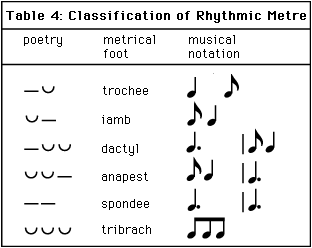
These examples show an excerpt of rhythmic neumes organized in pockets of three and two neumes, called ligatures, to indicate to the singer that they must sing the rhythm according to the first (trochee) rhythmic mode. Often, combinations of rhythmic modes were used in different voices giving the music even more variation. We could call this an early form of ‘polyrhythm.’
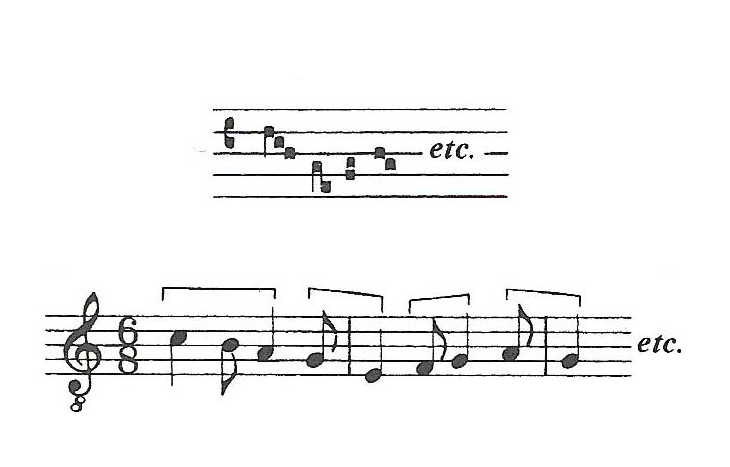
This allowed singers to sing music according to pitches and rhythm, albeit still limited in scope compared to the music that would follow in the next centuries. In addition, this School of Notre Dame innovation served a few purposes. Repertory could be written down and helped singers learn new pieces (they still learned music by rote). Music could be transported easily, and implementing the correct melodies and rhythms was made possible in centers across the Holy Roman Empire established by Charlemagne.
Léonin (d. 1201) flourished between 1150 and 1200 as a composer and teacher at Notre Dame. He was known for his polyphonic organum compositions, such as Viderunt Omnes (video, based on Psalm 97 in the Vulgate bible). In addition, the major choir book, Magnus Liber (‘great book’), is attributed to Léonin and Pérotin. However, it cannot be said with certainty.
Pérotin (c. 1174 – ca. 1225) followed his predecessor Léonin’s footsteps as a composer based at Notre Dame. His works were revolutionary for the time and expanded on the groundwork laid by Léonin. He composed organum works for more than two voices (organum duplum) in three-voice (organum triplum or triplum) and four-voice (organum quadruplum) iterations. It is believed that Pérotin introduced the concept of four-part polyphony in Western music (this would come to fruition in later periods and works such as J.S. Bach’s four-part chorales in the Baroque era, for example). He also expanded the Magnus Liber and contributed to the expansion of rhythm. We can compare his musical creations to the scope and innovation of Gothic cathedrals.
The composition offers a snapshot of the innovations in history: organum, polyphony, and discant.
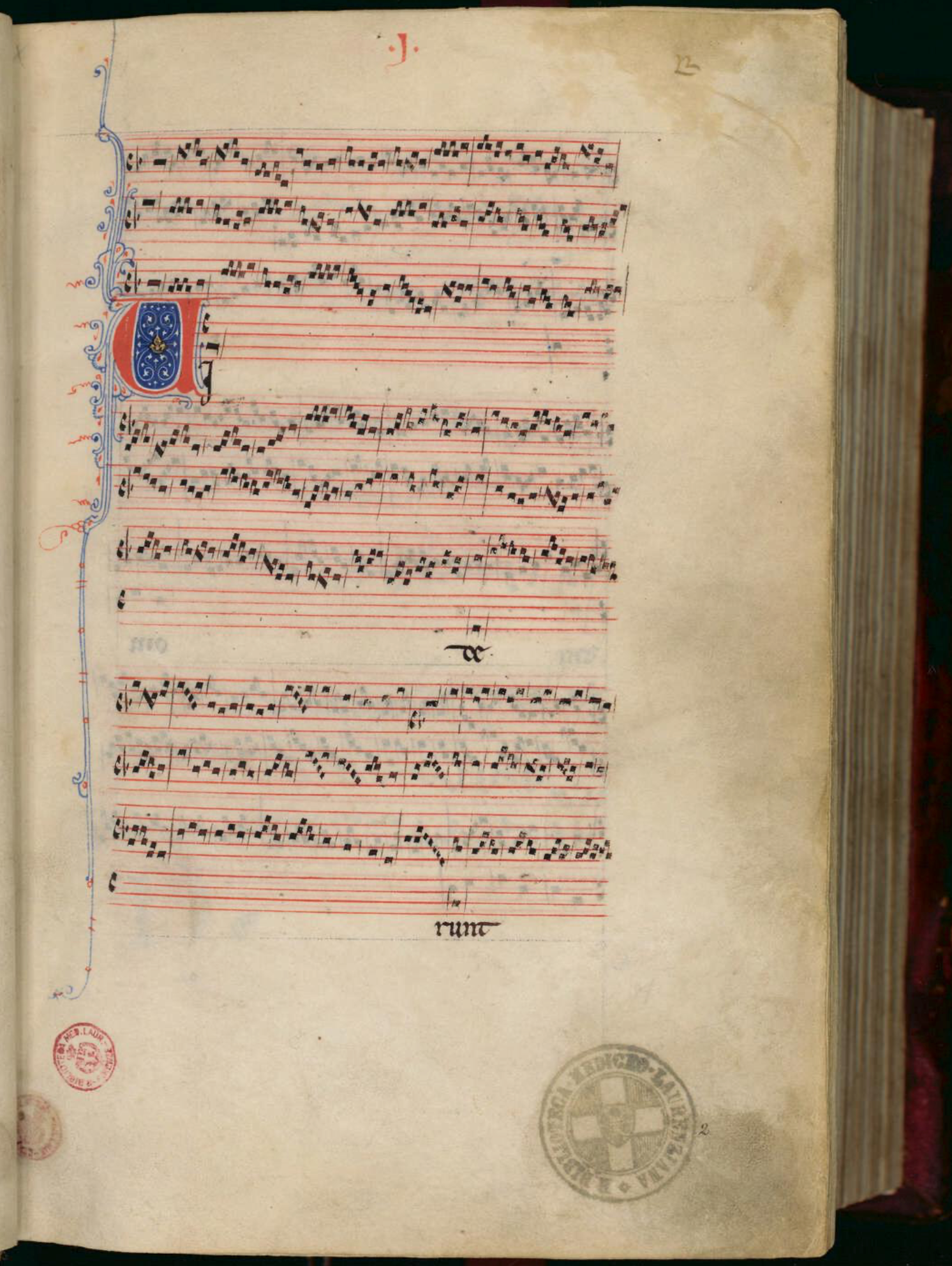
We can compare Leonin’s setting of Viderunt Omnes with Pérotin’s to see how organum and polyphony developed even further. While Léonin’s work is relatively simple in its scope with only two voices (one is singing the drone and the other moves about), Pérotin still uses the drone. Still, the upper-three voices sing in independent rhythms.
After the Norman conquest of England in 1066, the French influence was also markedly present in the British court and church. For example, Richard the Lionheart (1157—1159) was also a trouvère. Thus, France’s secular (and religious) music played a role in England.
Following the Continental methods of composition, English composers also extended these practices. For example, the intervals of a third and a sixth (three notes and six notes apart, respectively) were allowed in Notre Dame polyphony but not extensively used (they preferred fourths and fifths). This is because thirds and sixths were considered ‘imperfect’ consonances. Still, the English used them extensively, often in parallel motion (moving from one imperfect consonance to the next). Furthermore, the English composers preferred the long-short (first rhythmic mode) as opposed to the short-long (third rhythmic mode) preferred by the Notre Dame School.
An often-quoted example of English polyphony is the composition Summer is icumen in, written in Middle English around 1250. The song is the earliest musical round with English lyrics. Unfortunately, it is only known from a single manuscript, which a scribe most likely created at Oxford around the third quarter of the 13th century. The arrangement of the song allows vocalists to select between the Middle English words, which celebrate the arrival of spring, and the Latin lyrics, which are pious. This is the earliest surviving example of a piece of music that has both secular and religious words put to it. The text on the right of the page contains Latin instructions for performing it as a round, with the cross above the first line indicating the point at which each of the four primary voices enters.
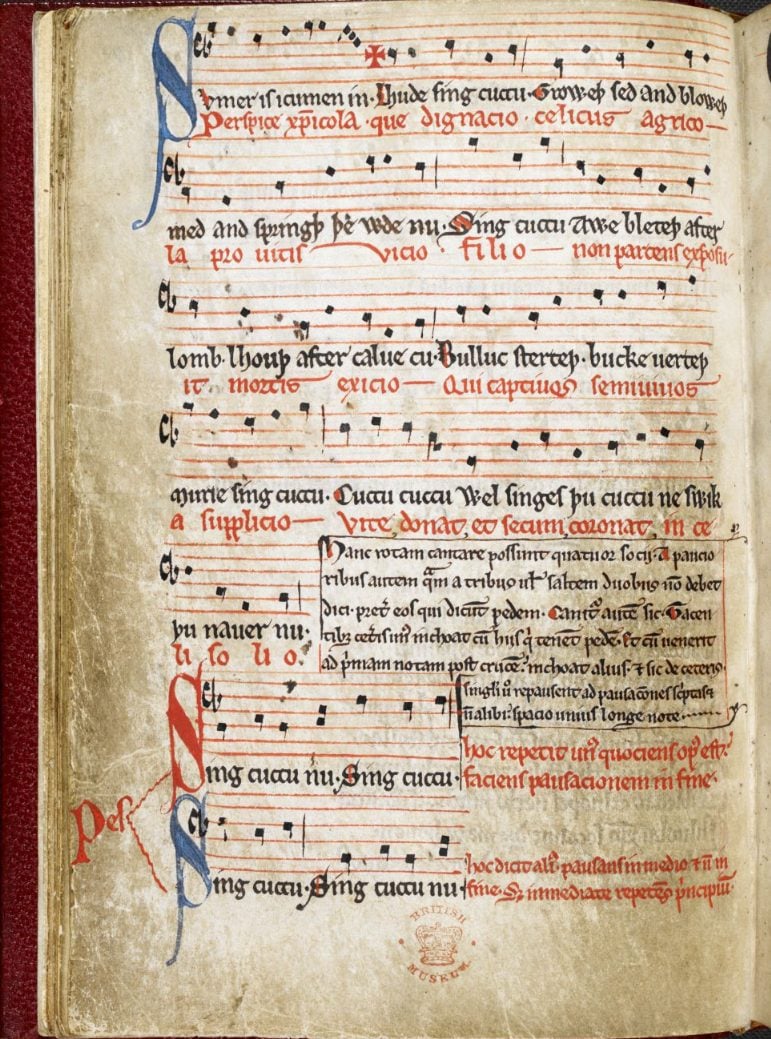
The Middle English text includes many familiar animal names such as cuccu (cuckoo), lomb (lamb) and cu (cow). Famously the bucke (buck) is said to farteth: the first record of the verb ‘to fart’.
British Library
The two lower voices sing the pes (Latin for foot), forming a rondellus. In a rondellus, the latter part of the first voice’s pes (foot) is copied by the second voice – the second half of the pes is the first half of the other. In the illustration below, Sing cuccu is first heard in the ‘blue’ pes and repeated in the ‘red’ pes above it; likewise, the ‘red’ pes’s Sing cuccu nu is ‘imitated’ by the ‘blue’ pes after singing Sing cuccu. We can also interpret this device as an onomatopoeia of the cuckoo’s call.
| ‘Red’ pes | Sing cuccu nu: | Sing cuccu! | Sing cuccu nu: | Sing cuccu! | etc. |
| ‘Blue’ pes | Sing cuccu! | Sing cuccu nu: | Sing cuccu! | Sing cuccu nu: | etc. |
In other words, there is a constant movement and overlap between the two tenor voices ‘imitating’ each other. In comparison, the four upper voices, one after the other, enter in canon, making this composition a rota or round.
Apart from liturgical music moving forward, further innovations and forms of music emerged, especially in the secular music scene.
First, the motet was used for liturgical purposes (but not during the Mass). Still, soon it could be sung on other occasions and even for entertainment. The tenor, which sang the principal chant melody in Gregorian chants, lost its importance. The tenor became the supporting framework for the upper voices. Additionally, composers innovated new possibilities:
Most of the points above are illustrated in two of Guillaume de Machaut’s motets (Quant en moy/Amour et biaute/Amara valde and De bon espoir/Puis que la douce/Speravi). The upper two voices sing texts in French, while the lower voice is Latin. It takes a bit of finetuning your ear to hear the different texts placed on top of each other and to distinguish each voice. Still, with practice, anyone can do this and enjoy the music. Or, just sit back and let the beauty flow over you.
Troubadours were poet-musicians writing their poems in Provence’s langue d’oc (Occitan). Often, they were of noble birth, had relatively great freedom of speech, and sometimes even entered or intervened in the political arena. However, their primary aim was to create an aura of amenity and cultivation around the court ladies. Troubadour poetry was significant and influenced later lyrical poetry throughout Europe. The troubadours were active in southern France, northern Spain, and northern Italy. Music for these poems was either composed by poets or experienced musicians. Unfortunately, very little of their written music survives, and recordings of such works are filled with guesswork and probably misleading.
The trouvères are the successors of the troubadours’ legacy, which they admired, with the difference that they were non-literate composers and poets who transmitted their songs in an oral tradition. They performed in a non-standardized version of French, or langue d’oil. Their music and poems were collected and transcribed by professional scribes, presumably for the benefit of patrons or collectors.
It is a modern misconception that troubadours and trouvères were traveling musicians. On the contrary, the jongleurs and minstrels were touring musicians but of a lower social class than the troubadours and trouvères.
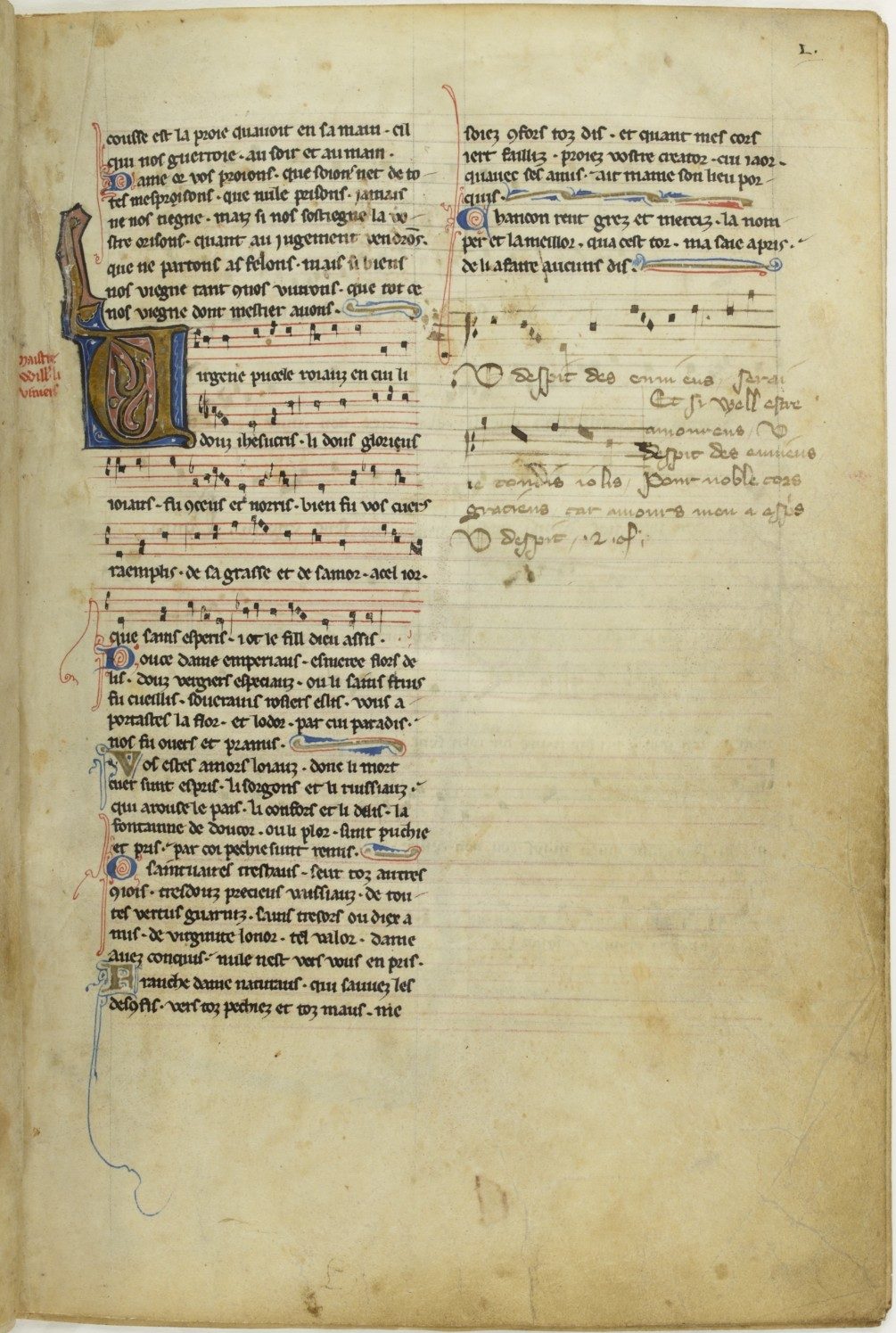
Lastly, the Minnesingers in Germany were often of noble birth as well. Again, the troubadours inspired their artistic movement. Their poetry’s themes tend to be dominated by a reverence for women, expressed in language that exalts courtly love. Although their music was set to music and accompanied by professional minstrels, few melodies have survived the two hundred years of their activity.
Franco of Cologne established a definitive system of ligatures by taking the ‘standard’ square notation (derived from earlier neumes). Although his work Ars Cantus Mensurabilis (written around 1260 or 1280) was filled with strict rules for applying square notes, it also brought much-needed flexibility to composers to write music with varying rhythms. The caveat was that Franco’s system (still) only allowed notes to be divided by three. Secondly, only officially recognized notes are long (longa), short (brevis), and semi-short (semi-brevis). Further divisions of the note into two would only come during the Ars Nova period (we’ll look at this in the next section).
The last century of the medieval period saw innovations from the High Medieval period come to fruition, especially notating music with independent rhythms. Standard forms of music also began to emerge across Europe.
An essential innovation relates to notating music with notation starting to resemble our modern notes. The Ars Nova period lasted around 67 years – it started with the preparation of the Roman de Fauvel (by Gervais du Bus). It ended with the death of the composer Guillaume de Machaut in 1377. In Roman de Fauvel, we find the genesis of the new style called Ars Nova.
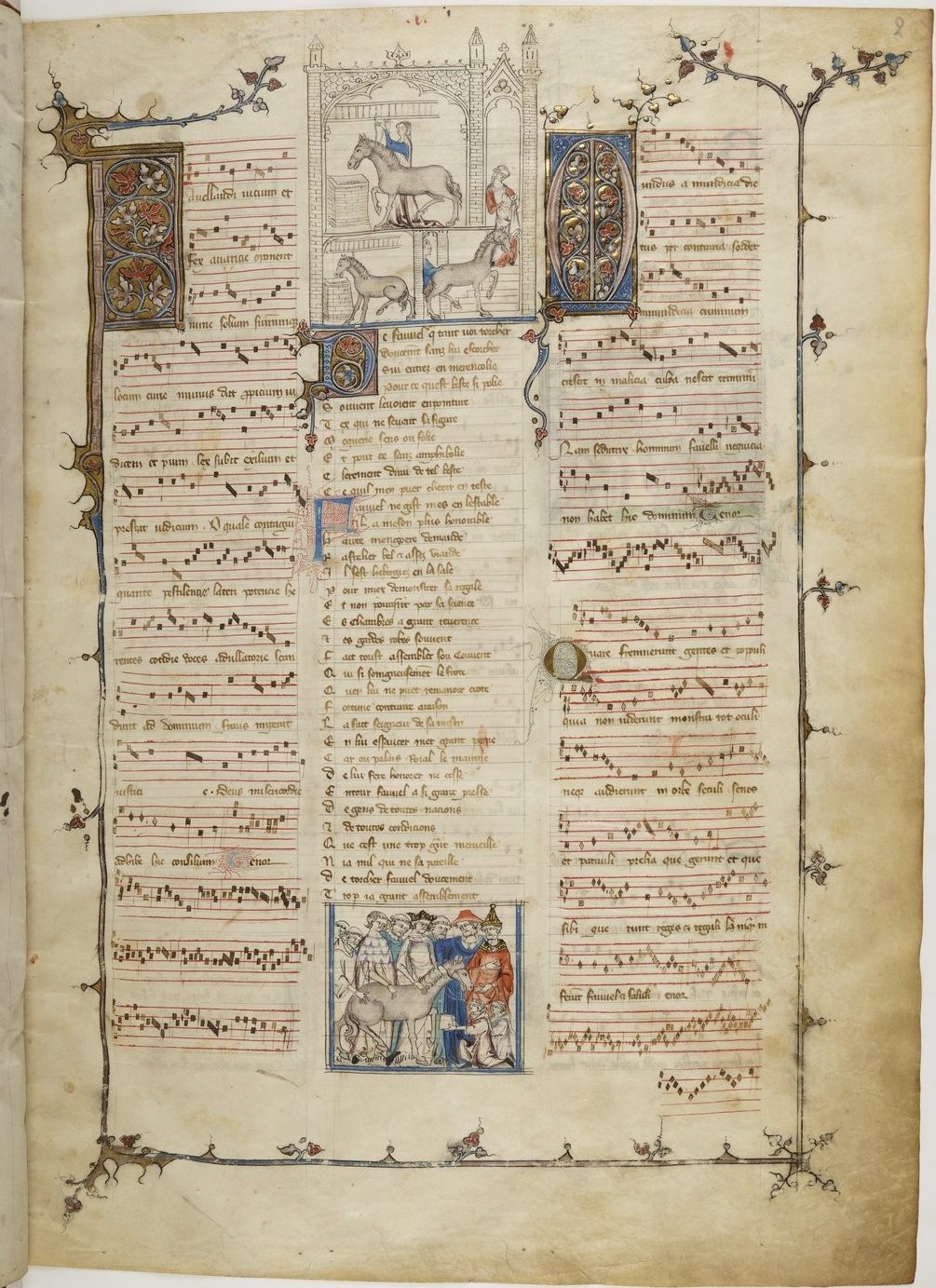
During this time, notation and rhythms expanded even further. Pitch and rhythm were unambiguous for the first time in written music history. What was composed in France could easily be interpreted in another location, and singers could convey the composer’s intentions while only having the manuscript to sing from. Composers realized that, just like poets, their works became permanent and started to attach their names to their work.
Philippe de Vitry’s (1261–1321) treatise Ars Nova (The New Art, ca. 1222–23) laid the foundations for mensural and isorhythmic notation and expanded the range of rhythmic possibilities. He was especially well-known for his isorhythmic motets; some were also included in the Roman de Fauvel.
Further innovations included:
Mensurations were indicated on the score in the music to show the ‘time signature’ or division of the beat.
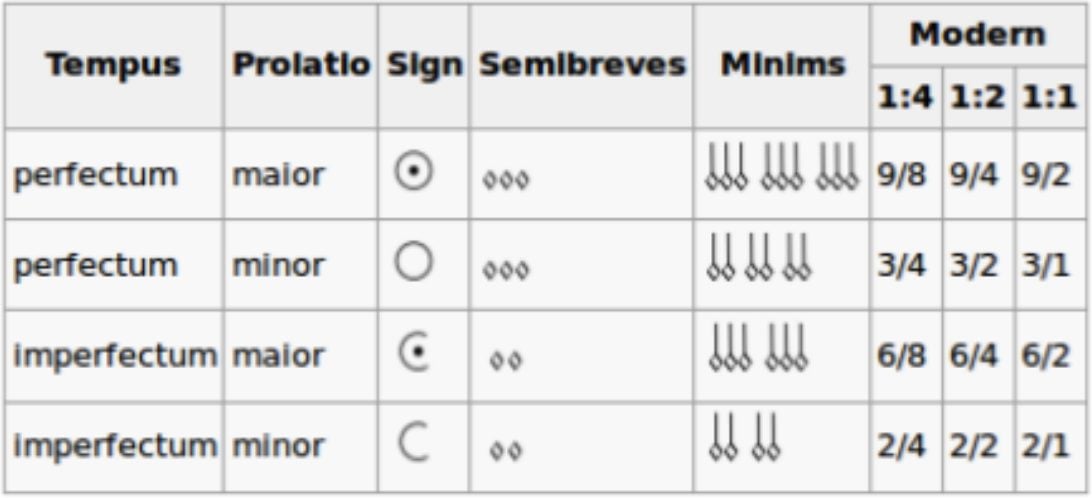
Guillaume de Mauchaut (ca. 1300–1377) was one of the most influential composers revered by his contemporaries and later artists. Machaut set himself apart by discussing his working methods and is among the first composers to compile his complete works in manuscripts – signs of his self-awareness as an artist and ensuring his name and work would be preserved for future generations. His major musical works include Messe de Notre Dame (video, the earliest complete setting of the Ordinary of the Mass attributable to a single composer) and Hoquetus David (video).
Although most of the music in the medieval period was centered around the church and religion, there was also secular music. Accompaniment of liturgical music with the organ occurred in the tenth century.
Because very few instrument specimens have survived from the Middle Ages, we must rely on iconography (the study of depictions in painting and sculpture), theoretical discussions, and relating those things to surviving music that appears to be intended for instruments. Unfortunately, few medieval writers deign to provide any practical knowledge about instruments. Johannes de Grocheo, presumably working in Paris about the year 1300, was among the first to do so. He categorizes instruments based on how they produce sound: those that utilize wind or breath (such as trumpets, shawms, flutes, and organs) and those that use percussion (such as drums, cymbals, bells, and—perhaps strangely to us—string instruments).
Later Medieval musicians began to observe a distinction between loud and soft instruments (haut and bas are the usual French terminology). As a result, mixed ensembles were made up entirely of instruments of one kind or the other, depending on whether loud or soft music was desired. Naturally, all of the string instruments fall into the soft category, and many of the wind instruments do, too, so it was possible to have combinations of wind and string instruments. In particular, at least one medieval writer mentions the joining of the flute and the fiddle. We’ll look at some of the instruments available in the medieval period, but remember that players would use them in secular music settings.
The organ may or may not have been to accompany the choir in the church, but this is a puzzle. The church took a dim view of the organ and was not part of Christian worship until some time in the tenth century. However, the organ provided a powerful tool for political and ecclesiastical purposes. Politically, the king was the only person with the means to afford an organ and place it in the church; this shows his benevolence to his subjects and power. Ecclesiastically, the organ was a sign of power because it was only found in the church and could produce thunderous and deep sounds. These theories about the organ are still to be proved or disproved.
The earliest depictions of organs are called portative organs (from the Latin portare — ‘to carry’). From the 12th through the 16th centuries, this little forerunner of the organ was one of the most popular instruments. A player would hang it around their neck and consist of a sheepskin and wood bellows, a keyboard, and a row of pipes that created a flute-like sound when the bellows were compressed, and the player tapped the keys.
It could only play one note at a time, unlike its modern-day counterparts. As a result, it was primarily utilized for monophonic dancing music or as a solo part in a motet, chanson, or other polyphonic piece.
Love it or hate it, the recorder has a long history that dates back to the Middle Ages (and possibly earlier). The recorder is the most advanced member of the ancient family of internal duct flutes (the inner tube passing down the middle of the instrument), which consist of flutes with a fixed windway made from a wooden stopper or block. It is distinguished from other internal duct flutes by having openings for seven fingers and a single hole for the upper hand’s thumb.
The shawm is a powerful double-reed woodwind instrument made in Europe beginning in the 13th century. It played an essential part in dancing bands and ensembles for municipal and court occasions throughout the medieval period. In addition, it was widely employed to deliver the ‘all’s well’ from the town tower during social and ceremonial events as a precursor to the oboe.
The vielle is the great-grandparent of the modern violin. It is a bowed instrument and one of the most favored medieval instruments. It had a rectangular body with rounded corners with four or five strings. From pictorial evidence between the tenth century and 1400, it was probably constructed so that the lower strings would act as a drone.
The lute was another popular instrument during this time. It was introduced to Europe when the Moors invaded Spain in the 8th century. Its popularity increased with the Crusades, making more contact with the Arabic world around 1100. Although no examples from the Middle Ages exist, it was widely shown in many artworks found in manuscripts and depictions in sculptures. A player plucked the strings with a quill, and the instrument was primarily used to add an improvised accompaniment to vocal music.
In France, the hurdy-gurdy, also known as the vielle à roue (‘vielle with the wheel’ French), was a string instrument intended mainly to generate drones. The sound was caused by a rosined wooden wheel rotated by a crank, which placed several strings in continuous droning vibration. One of these was a melody string, which could play tunes when it was stopped by keys along its length. The hurdy-gurdy was introduced in England in the 12th century. It remained a popular instrument until the end of the medieval period. At its first appearance in the 10th century, it was a large and unwieldy instrument that required two persons to play it – one turning the crank and the other forming melodies.
Some of the instruments from this period would undergo further development in the Renaissance period (the organ, vielle, lute, and recorder, for example), while others would fall out of popularity or seize to exist.
The medieval period was not a time of darkness but innovation, discovery, and stretching of the status quo. As a result, the foundation for music notation and music theory methods was laid. During this period, the Notre Dame School in France was at the forefront of developing many of the innovations found in music. Charlemagne’s consolidation of most of Europe into the Holy Roman Empire certainly helped to solidify France’s place in the history and development of music. Charlemagne’s cultural policies and educational reforms also helped move music forward. Ultimately, Western music would build on the medieval period’s foundations and progress toward the Renaissance.
